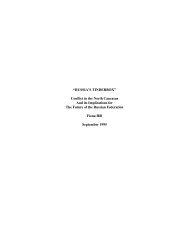Russia - Belfer Center for Science and International Affairs - Harvard ...
Russia - Belfer Center for Science and International Affairs - Harvard ...
Russia - Belfer Center for Science and International Affairs - Harvard ...
Create successful ePaper yourself
Turn your PDF publications into a flip-book with our unique Google optimized e-Paper software.
house NBC materials <strong>and</strong> components that can be used in the construction of weapons of mass<br />
destruction. Finally, in an appendix, the paper offers recommendations on what <strong>Russia</strong>n authorities<br />
should do to minimize the possibility of catastrophic nuclear terrorism.<br />
II. Threat of Nuclear Terror: Why the Kremlin Should Be Concerned<br />
The disintegration of the Soviet Union left 40,000 nuclear weapons, more than 1,000 metric<br />
tons of nuclear materials, vast quantities of chemical weapons <strong>and</strong> biological materials, <strong>and</strong><br />
thous<strong>and</strong>s of missiles scattered across several independent states. 9 The largest portions of this<br />
deadly arsenal were concentrated in <strong>Russia</strong>, Ukraine, <strong>and</strong> Kazakhstan, which faced the biggest<br />
challenge to secure these materials. Frantic ef<strong>for</strong>ts by the <strong>Russia</strong>n <strong>and</strong> U.S. governments coupled<br />
with the good will of the other <strong>for</strong>mer Soviet states have brought most of the arsenal to <strong>Russia</strong> <strong>for</strong><br />
storage <strong>and</strong> disposal. However, the decentralized <strong>and</strong> weak country was initially unprepared to<br />
safeguard the stockpiles accumulated by the totalitarian Soviet regime.<br />
The Soviet Union took pains to maintain a strong second line of defense against<br />
proliferation of NBC materials by making its borders impenetrable from within <strong>and</strong> without. 10 But<br />
post-communist democratic <strong>Russia</strong> can ill af<strong>for</strong>d to build a strong Iron Curtain. Instead <strong>Russia</strong>n<br />
authorities have focused on strengthening the first line of defense: security perimeters at nuclear<br />
facilities. Considerable improvements in security have been made during the past decade at the<br />
Defense Ministry’s nuclear facilities, as <strong>Russia</strong>n authorities view the threat of terrorism <strong>and</strong><br />
proliferation more seriously. Acknowledging the scope of this danger, <strong>Russia</strong>n policymakers have<br />
9 “A Report Card on the Department of Energy’s Nonproliferation Programs with <strong>Russia</strong>,” the Secretary of Energy<br />
Advisory Board, The United States Department of Energy, January 10, 2001, available as of May 13, 2002 at<br />
http://www.hr.doe.gov/seab/rusrpt.pdf.<br />
4
















